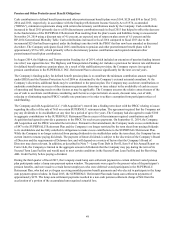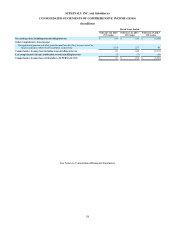Albertsons 2015 Annual Report Download - page 52
Download and view the complete annual report
Please find page 52 of the 2015 Albertsons annual report below. You can navigate through the pages in the report by either clicking on the pages listed below, or by using the keyword search tool below to find specific information within the annual report.50
OFF-BALANCE SHEET ARRANGEMENTS
Guarantees
The Company has outstanding guarantees related to certain leases, fixture financing loans and other debt obligations of various
retailers as of February 28, 2015. These guarantees were generally made to support the business growth of independent retail
customers. The guarantees are generally for the entire terms of the leases or other debt obligations with remaining terms that
range from less than one year to 15 years, with a weighted average remaining term of approximately eight years. For each
guarantee issued, if the independent retail customer defaults on a payment, the Company would be required to make payments
under its guarantee. Generally, the guarantees are secured by indemnification agreements or personal guarantees of the
independent retail customer.
The Company reviews performance risk related to its guarantees of independent retail customer obligations based on internal
measures of credit performance. As of February 28, 2015, the maximum amount of undiscounted payments the Company
would be required to make in the event of default of all guarantees was $69 ($54 on a discounted basis). Based on the
indemnification agreements, personal guarantees and results of the reviews of performance risk, the Company believes the
likelihood that it will be required to assume a material amount of these obligations is remote. Accordingly, no amount has been
recorded in the Consolidated Balance Sheets for these contingent obligations under the Company’s guarantee arrangements.
The Company is contingently liable for leases that have been assigned to various third parties in connection with facility
closings and dispositions. The Company could be required to satisfy the obligations under the leases if any of the assignees are
unable to fulfill their lease obligations. Due to the wide distribution of the Company’s assignments among third parties, and
various other remedies available, the Company believes the likelihood that it will be required to assume a material amount of
these obligations is remote.
The Company is a party to a variety of contractual agreements under which it may be obligated to indemnify the other party for
certain matters in the ordinary course of business, which indemnities may be secured by operation of law or otherwise. These
agreements primarily relate to the Company’s commercial contracts, the TSA (as defined below), contracts entered into for the
purchase and sale of stock or assets, operating leases and other real estate contracts, financial agreements, agreements to
provide services to the Company and agreements to indemnify officers, directors and employees in the performance of their
work. While the Company’s aggregate indemnification obligation could result in a material liability, the Company is not aware
of any matters that are expected to result in a material liability.
Following the sale of NAI, the Company remains contingently liable with respect to certain self-insurance commitments and
other guarantees as a result of parental guarantees issued by SUPERVALU INC. with respect to the obligations of NAI that
were incurred while NAI was a subsidiary of the Company. As of February 28, 2015, using actuarial estimates as of December
31, 2014, the total undiscounted amount of all such guarantees was estimated at $217 ($195 on a discounted basis). Based on
the expected settlement of the self-insurance claims that underlie the Company’s commitments, the Company believes that such
contingent liabilities will continue to decline. Subsequent to the sale of NAI, NAI collateralized most of these obligations with
letters of credit and surety bonds to numerous states. Because NAI remains a primary obligor on these self-insurance and other
obligations and has collateralized most of the self-insurance obligations for which the Company remains contingently liable,
the Company believes that the likelihood that it will be required to assume a material amount of these obligations is remote.
Accordingly, no amount has been recorded in the Consolidated Balance Sheets for these guarantees.
Multiemployer Plans
The Company contributes to various multiemployer pension plans under collective bargaining agreements, primarily defined
benefit pension plans. These multiemployer plans generally provide retirement benefits to participants based on their service to
contributing employers. The benefits are paid from assets held in trust for that purpose. Plan trustees typically are responsible
for determining the level of benefits to be provided to participants as well as the investment of the assets and plan
administration. Trustees are appointed in equal number by employers and unions that are parties to the collective bargaining
agreement.
Expense is recognized in connection with these plans as contributions are funded, in accordance with Accounting Standards.
The Company made contributions to these plans, and recognized expense, of $39, $39 and $38 in fiscal 2015, 2014 and 2013,
respectively. Company contributions to these plans could increase in the near term. However, the amount of any increase or
decrease in contributions will depend on a variety of factors, including the results of the Company’s collective bargaining
efforts, investment returns on the assets held in the plans, actions taken by the trustees who manage the plans and requirements
under the Pension Protection Act, the Multiemployer Pension Reform Act and Section 412(e) of the Internal Revenue Code.
Furthermore, if the Company were to significantly reduce contributions, exit certain markets or otherwise cease making
























